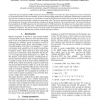Free Online Productivity Tools
i2Speak
i2Symbol
i2OCR
iTex2Img
iWeb2Print
iWeb2Shot
i2Type
iPdf2Split
iPdf2Merge
i2Bopomofo
i2Arabic
i2Style
i2Image
i2PDF
iLatex2Rtf
Sci2ools
LREC
2010
2010
WAPUSK20 - A Database for Robust Audiovisual Speech Recognition
Audiovisual speech recognition (AVSR) systems have been proven superior over audio-only speech recognizers in noisy environments by incorporating features of the visual modality. In order to develop reliable AVSR systems, appropriate simultaneously recorded speech and video data is needed. In this paper, we will introduce a corpus (WAPUSK20) that consists of audiovisual data of 20 speakers uttering 100 sentences each with four channels of audio and a stereoscopic video. The latter is intended to support more accurate lip tracking and the development of stereo data based normalization techniques for greater robustness of the recognition results. The sentence design has been adopted from the GRID corpus that has been widely used for AVSR experiments. Recordings have been made under acoustically realistic conditions in a usual office room. Affordable hardware equipment has been used, such as a pre-calibrated stereo camera and standard PC components. The software written to create this co...
Audio-only Speech Recognizers | Audiovisual Speech Recognition | Education | LREC 2010 | Pre-calibrated Stereo Camera |
| Added | 29 Oct 2010 |
| Updated | 29 Oct 2010 |
| Type | Conference |
| Year | 2010 |
| Where | LREC |
| Authors | Alexander Vorwerk, Xiaohui Wang, Dorothea Kolossa, Steffen Zeiler, Reinhold Orglmeister |
Comments (0)

